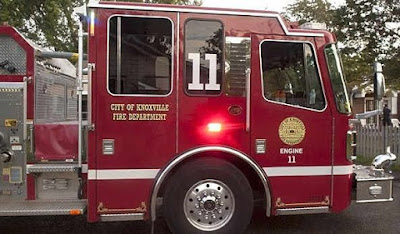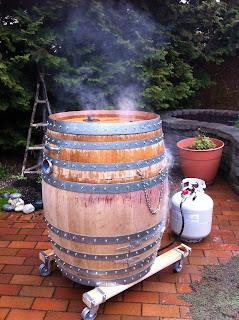1. Plan Ahead
It takes a while to thaw a bird, so buy your turkey well in advance and get it into the fridge several days before you plan on soaking (in brine) and smoking. Here's a helpful guide I found on Foodsafety.gov:
2. Remove the Extra Parts & Rinse
If you bought a whole bird, you'll find the neck, liver, gizzard, heart, etc. stuffed in the front and main cavities. Be sure to remove these before you get started. Rinse the turkey well with cold running water.
3. Mix the Brine
Here are my recommended brine ingredients (for a 12-14 pound bird):
1 medium onion (quartered)
2 apples (sliced)
2 oranges (sliced)
1 bulb garlic (halved)
1 tbs black peppercorns (whole)
1-1/2 cup kosher salt
1-1/2 cup sugar
1/2 cup brown sugar
2 tbs sorghum molasses
1 cup whiskey (cheap)
rosemary, sage, thyme (I use about 1 tbs each of large leaves dried from the herb garden)
water as needed to cover the bird
It works best to start with a small amount of hot water to dissolve the salt, sugar and mix in the molasses, then combine whiskey and the remaining dry ingredients. Add fruit and pour in cold water to create the desired quantity of brine.
Feel free to substitute ingredients or toss in other sweet or savory items that might add a hint of desired flavor to your bird (e.g. maple syrup, apple cider, cloves, bay leaves, etc.)
4. Brine the Bird
Place the thawed turkey in the brine, leg end up. Jiggle it around until fully submerged and surrounded by the brine ingredients. Cover and soak 24 hours in the refrigerator. Make sure the entire bird stays submerged. Invert the bird halfway through if needed to ensure it brines fully.
5. Inject the Bird
For added flavor, melt four tablespoons of salted butter and inject in small quantities to all parts of the bird with a food injector syringe.
6. Smoke the Bird
Don't throw that brine away! If you're using a water-bath smoker, collect fruit and spices from the brine and toss them in the water bath. You may also wish to use a 50/50 mixture of water and apple juice or apple cider in the bath instead of just plain water.
Fire up your smoker, load the chips, and cook the bird. Tie the legs and wings in tight against the body and place it on the rack. Maintain a smoker temperature of 225-250 deg F and keep the smoke rolling for at least three hours. At this point the bird has acquired a good smoke flavor. You should begin basting the bird with melted butter about every hour to create a golden finish. A thermometer placed in the thigh should register 170 deg F before you remove the bird from the smoker.
7. Remove, Rest & Carve
Remove the bird from the smoker, place on a warm platter, and drape a sheet of aluminum foil over it to rest for about 20 minutes before serving.
8. Enjoy!




















































